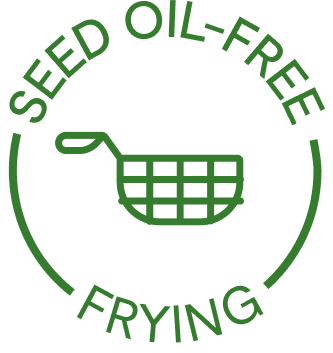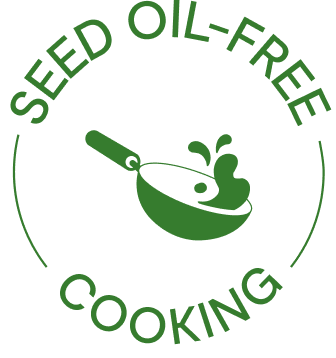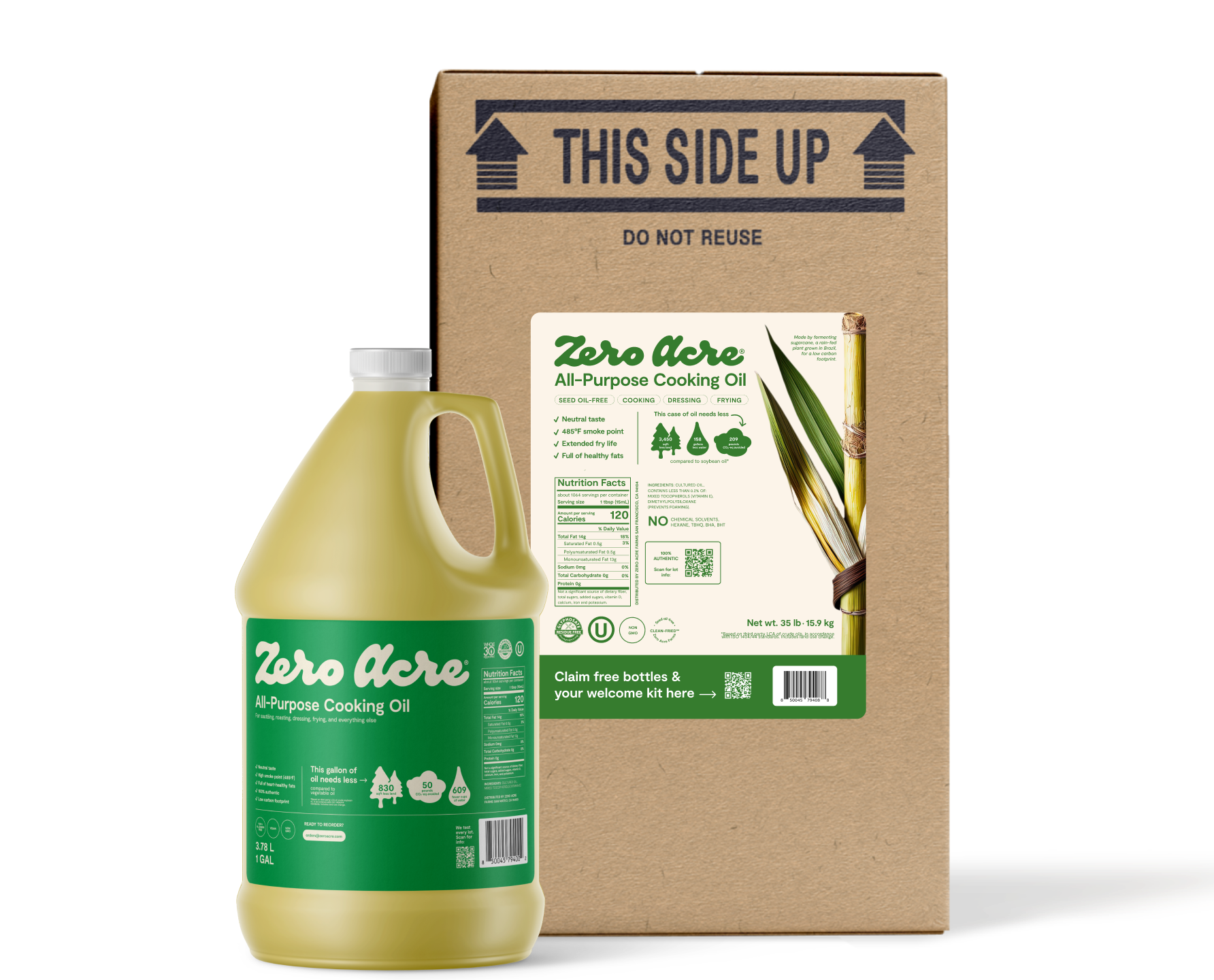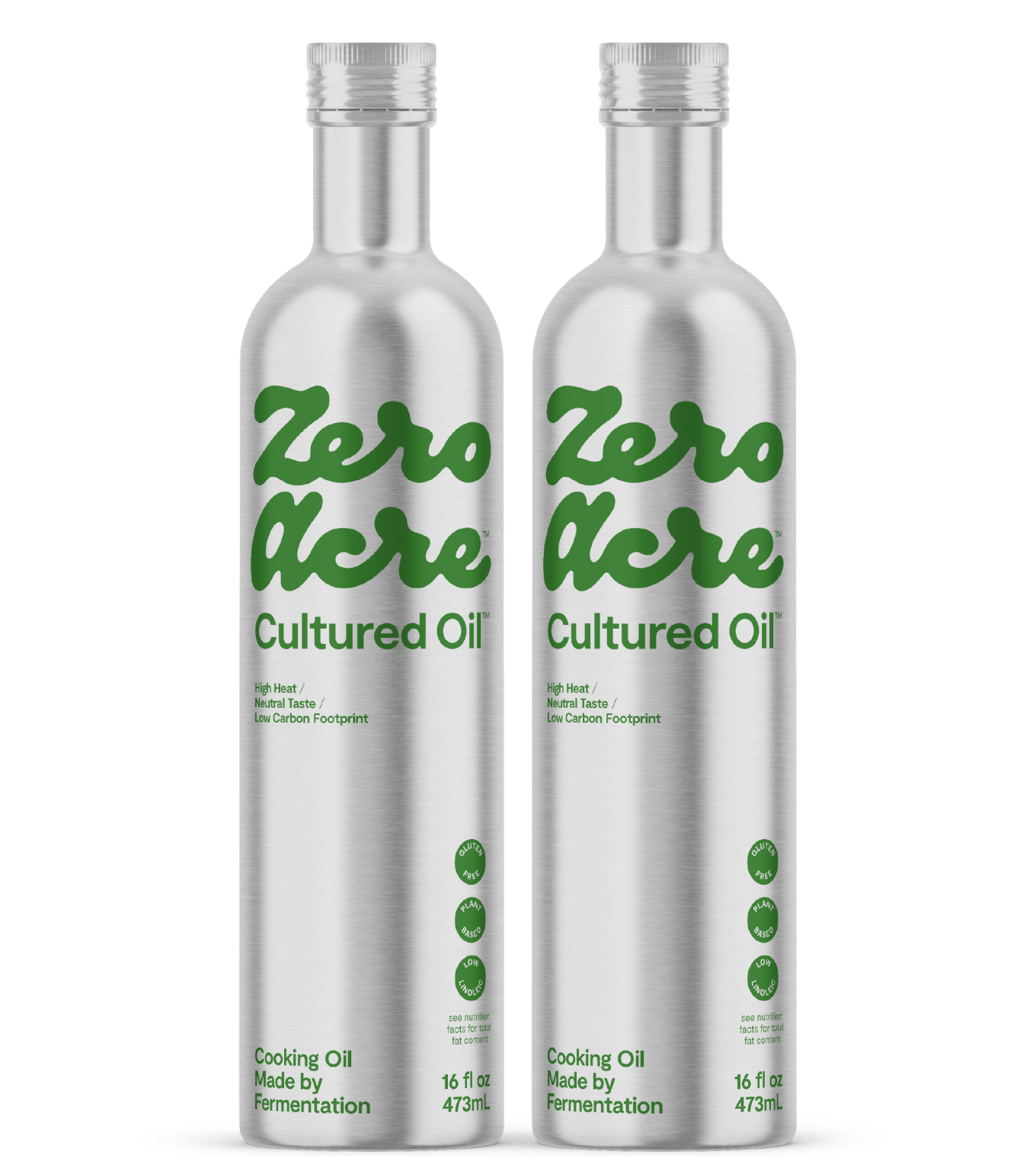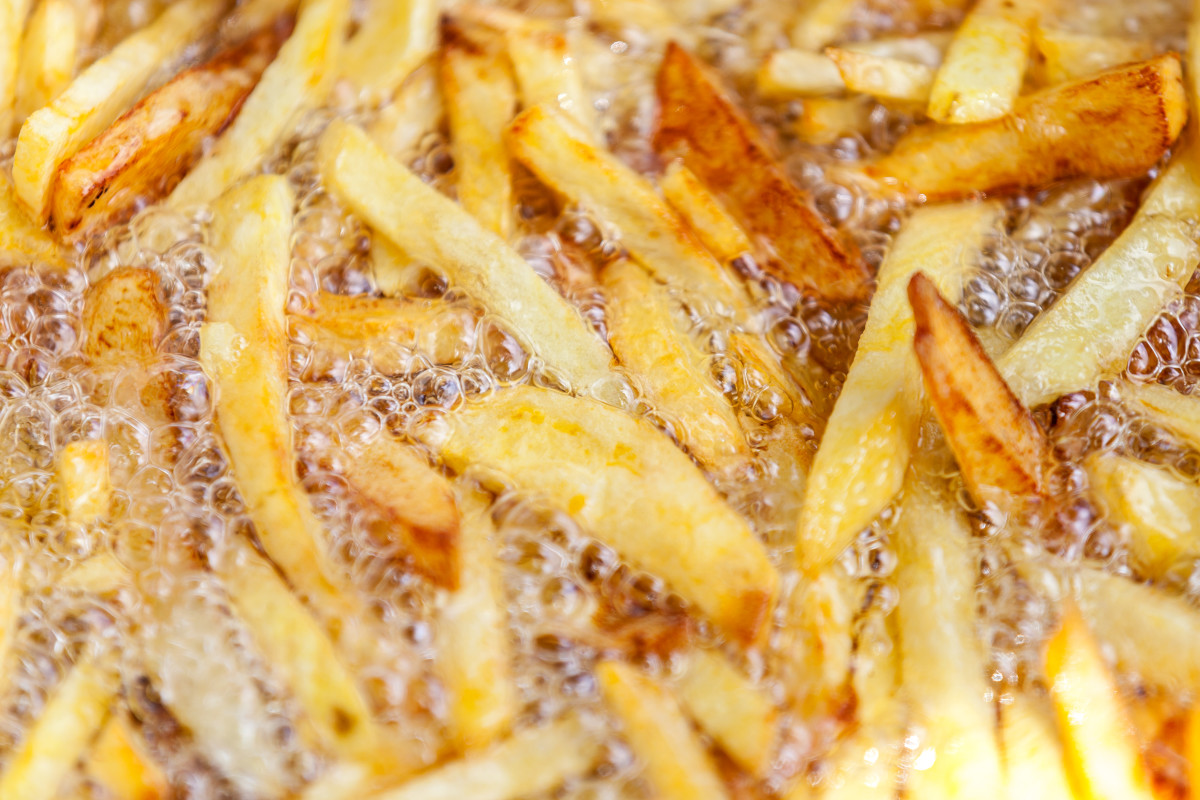WRITTEN BY: Corey Nelson
Article at a Glance
Most common frying oils are cheap vegetable oils high in linoleic acid, an inflammatory omega-6 fatty acid that breaks down when heated.
The main reason fried food is unhealthy may be that it’s fried in seed oils, which are high in inflammatory fats that break down easily when continually heated
Switching to lower linoleic acid oils and cooking at home is a better alternative for healthier, tastier fried food.
The healthiest cooking oils for frying are heat-stable and have a neutral or complementary flavor for your recipes.
Along with choosing the right oil for your frying needs, proper frying techniques and correct temperatures are also essential.
Introduction
Fried foods are delicious, but studies show they’re among the worst foods for your health. The reason? The most commonly used frying oils aren’t suitable for high heat or reheating and actually cause inflammation, weight gain, cardiovascular disease, and other health problems [*,*,*,*,*].
Changing the oil you use for frying by switching from more common vegetable oils to smarter alternatives is an easy way to make fried recipes healthier. And not only that — your favorite recipes will actually taste better, too.
This guide covers all the available options for frying oils, with pros, cons, how to choose the right oil for your needs, healthy frying tips, summaries from scientific research, and more.

The Best and Worst Oils For Frying
There are pros and cons to every oil and fat, from their smoke point and oxidative stability to their taste, versatility, and environmental impact. Here are some of the best and worst oils and fats for frying in alphabetical order.
Avocado Oil
Avocado oil is a brilliant green oil that's pressed from the pulp of avocados. It's suitable for use in cooking (including frying), sauces, and dressings.
Pros:
Extra virgin avocado oil’s smoke point is between 428-482°F, making it an excellent choice for high-heat cooking [*].
It’s high in monounsaturated fats and vitamin E [*].
Cons:
Avocado oil isn’t flavor-neutral. While mild, it can lend a nutty or grassy taste to fried foods.
It’s lower in omega-6 linoleic acid (LA) than vegetable oils made from seed crops but still contains 13.4% LA on average [*]. For context, Zero Acre oil contains less than 3% linoleic acid.
Avocado farming has significant negative environmental effects due to land use, water consumption, and biodiversity loss [*,*,*].
Should You Use Avocado Oil for Frying?
Aside from the environmental downsides, avocado oil is a top choice for frying. For less avocado flavor you can use virgin avocado oil (as opposed to extra virgin), although it has a lower smoke point of around 392°F, so you should only use it for lower temperature sauteing [*].
Butter and Other Animal Fats
Animal fats like butter, ghee (clarified butter with milk solids removed), lard (pork fat), bacon grease, tallow (beef fat), and duck fat were the most commonly used fats for frying before the introduction of low-cost seed oils [*]. In the 20th century, hydrogenated seed oils (high in harmful trans fats) advertised as a healthy, affordable alternative, became more popular.
Pros:
Some animal fats add desirable taste and texture properties, especially when using traditional recipes (for example, French cuisine relies heavily on butter, and many recipes from the American South use bacon fat).
Ghee (clarified butter) has a high smoke point (approximately 482°F) and is relatively stable at high heat [*].
Grass-fed, pastured dairy cows or other animals raised using regenerative agricultural methods may have a positive effect on climate change and other environmental outcomes [*].
Cons:
Non-ruminant animal fats like lard, bacon grease, and duck fat are high in inflammatory linoleic acid when animals consume corn and soy, which is usually the case [*].
Industrial or “factory” farming has a negative environmental impact due to pollution, land degradation, and climate change [*,*].
Butter has a low smoke point (300-350°F) due to the milk solids.
Animal fats affect the flavor of fried recipes, which can be undesirable.
Animal fats aren’t vegan-friendly.
Should You Use Animal Fats for Frying?
Unless you're vegan or plant-based, you can selectively use animal fats for frying, preferably from environmentally friendly animal sources that aren’t fed corn- or soy-based feeds.
Canola Oil
Canola oil is an industrial seed oil made from rapeseed using high-heat and high-pressure mechanical extraction techniques [*].
Pros:
Canola oil has a neutral taste, although it sometimes tastes mildly rancid due to unstable, oxidized fatty acids.
It’s traditionally low in cost.
Cons:
Containing 25% linoleic acid and 10% alpha-linolenic acid, canola is high in unstable polyunsaturated fatty acids (PUFAs) [*].
High heat and pressure during manufacturing damage canola oil and create harmful byproducts [*].
With a smoke point as low as 375°F, canola isn’t suitable for high-heat frying [*].
Canola and other seed oil crops use excessive amounts of land and water [*,*]. They also pollute the environment when sprayed with herbicides and pesticides or processed with industrial solvents.
Should You Use Canola Oil for Frying?
Canola oil isn’t a good choice for frying, or for consuming at all. Even setting aside the environmental impact, its high omega-6 linoleic acid levels and low heat stability make it a bad option.
Coconut Oil
Coconut oil, produced from the fruit of the coconut palm, is a solid fat at room temperature.
Pros:
Coconut oil is extremely low in polyunsaturated fats (PUFAs), containing only 2% linoleic acid [*].
Because of its low PUFA content, coconut oil is heat stable, with a typical smoke point of 375°F [*].
Although it contains over 80% saturated fats, the medium-chain fatty acids are different from those in animal fats [*].
The tropical coconut flavor of this oil may go well with certain fried foods.
Cons:
Like other oil crops, coconut oil production has a significant environmental impact, and it’s linked with the loss of tropical biodiversity [*].
Should You Use Coconut Oil for Frying?
Coconut oil is a good option for medium-heat frying if you enjoy the taste of coconut. Refined coconut oil has less coconut flavor and may have a higher smoke point. But coconut oil remains a poor choice if you’re concerned about its environmental impact.
Corn Oil
Corn oil is an inexpensive, commonly used vegetable oil extracted from corn using heat, pressure, and solvents.
Pros:
Cons:
Corn oil is high in omega-6 linoleic acid (LA), containing 53.5% LA [*].
Due to its high linoleic acid content, corn oil oxidizes at 356°F, well below its smoke point [*].
A randomized controlled trial linked corn oil consumption with 3.5-fold higher all-cause mortality (death) [*].
Should You Use Corn Oil for Frying?
Don’t be fooled by the high smoke point — you never fry with corn oil because it’s unstable and high in inflammatory linoleic acid.
Cottonseed Oil
Cotton oil is extracted from the seeds of cotton crops. Like other seed oils, the industrial extraction process uses heat, high pressure, and chemical solvents.
Pros:
Cons:
Cottonseed oil contains 51.5% omega-6 linoleic acid, making it inflammatory as well as unstable when heated during frying [*].
The environmental impact of cottonseed oil is less than many seed oils because it’s a byproduct of producing cotton for other purposes, but still significant [*,*].
Cotton is not food.
Should You Use Cottonseed Oil for Frying?
Skip the cottonseed oil for frying and other uses. The low cost isn’t worth the health problems and other downsides.
Zero Acre Oil
Zero Acre oil is a new type of cooking and culinary oil made through fermentation. It's stable for frying, high in heart-healthy monounsaturated fats, and exceptionally environmentally friendly.
Benefits
Zero Acre oil contains more than 90% monounsaturated fatty acids, the same heart-healthy fats found in olive oil and avocado oil.
Contains less than 3% omega-6 linoleic acid.
High smoke point of 485°F.
Extremely stable for heating and frying.
Light, fresh, neutral taste.
Natural antioxidants known as mixed tocopherols, a form of vitamin E, help protect against oxidation while frying and rancidity during storage.
Environmentally friendly with 85% less land use than canola oil, 86% lower emissions than soybean oil, and 99% lower water requirement compared to olive oil.
Vegan-friendly and GMO-free.
How to Use Zero Acre Oil
Zero Acre oil is an all-purpose cooking oil that stays liquid in the fridge and at room temperature and boasts one of the highest smoke points on the market. You can use it for everything from homemade dressings and marinades to baking and high-heat stir-frying and sauteing.
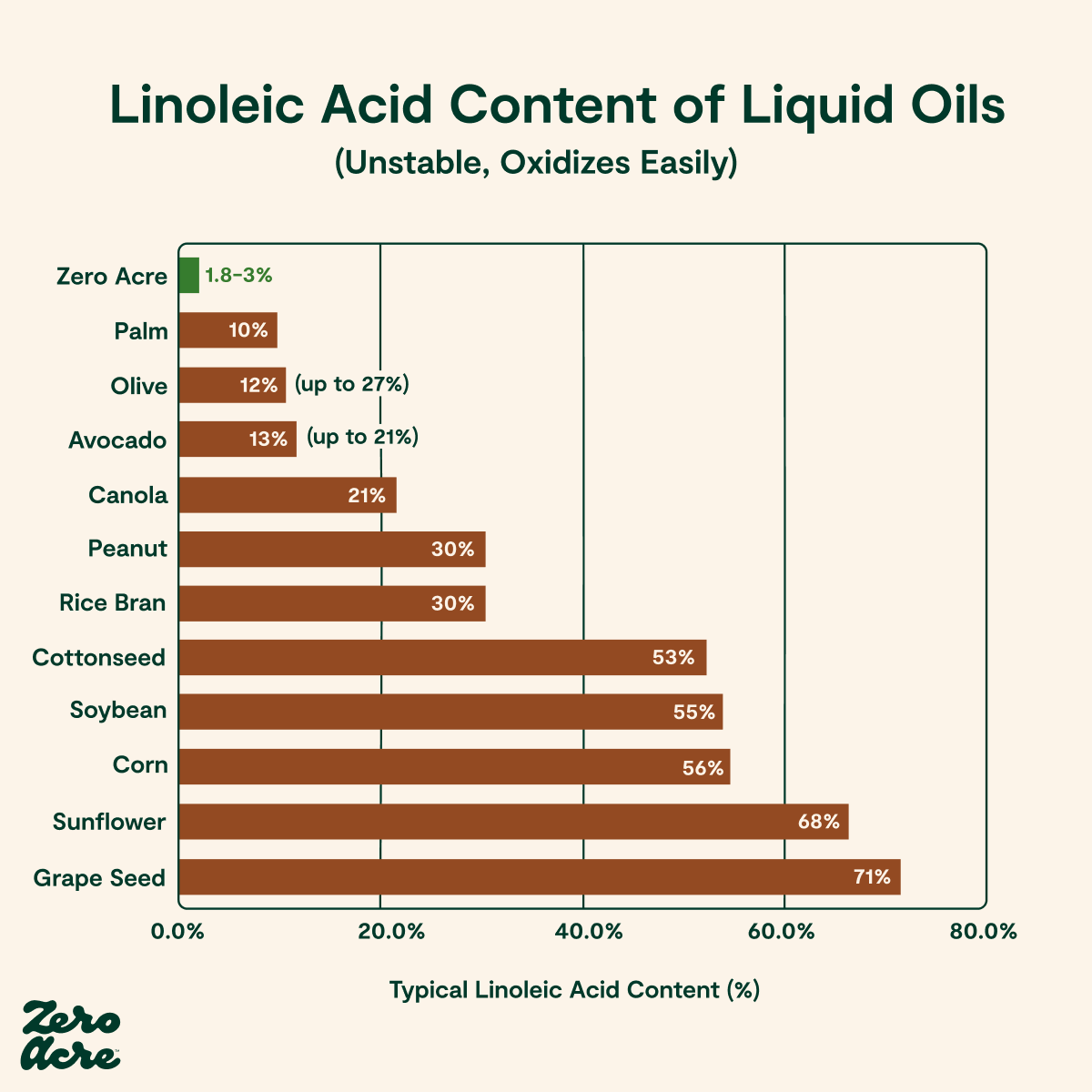
Grapeseed Oil
Grapeseed oil is extracted from the seeds of grapes, often from the winemaking industry. It’s liquid at room temperature and has a pale light-color.
Pros:
Neutral flavor
Although rarely used in commercial frying applications, unrefined grapeseed oil is high in antioxidants [*].
As a byproduct of wine production and other industries instead of a primary crop, grapeseed oil may be more environmentally friendly than other seed oils.
Cons:
Grapeseed oil contains nearly 70% omega-6 linoleic acid [*,*].
It’s relatively expensive.
Expeller-pressed grapeseed oil is damaged during processing, creating harmful byproducts [*].
Grapeseed oil also breaks down during storage and when heated under frying conditions [*].
Should You Use Grapeseed Oil for Frying?
Grapeseed oil has a reputation as a healthy seed oil, but in reality it's higher in harmful linoleic acid than most seed oils. Due to its high linoleic acid content, even cold-pressed grapeseed oil is highly prone to breaking down and forming harmful byproducts during frying.
Peanut Oil
Peanut oil is one of the most popular seed oils in restaurant-fried foods. It has a golden-brown color.
Pros:
Inexpensive
Neutral taste
Moderate smoke point (up to 450°F)
Cons:
Contains 32% omega-6 linoleic acid [*].
Highly prone to oxidation (damage to fatty acids) during frying [*].
Should You Use Peanut Oil for Frying?
Despite the high smoke point, peanut oil is still too high in inflammatory linoleic acid and isn’t heat-stable enough for frying.
Olive Oil
Olive oil is a golden-green oil that’s liquid at room temperature, but becomes solid when refrigerated. It’s a staple in the Mediterranean diet and many recipes from that region.
Pros:
Extra virgin olive oil is rich in monounsaturated fats and polyphenol antioxidants [*].
Moderate smoke point (356-406°F).
More resistant to oxidation during frying compared to most vegetable oils [*].
Cons:
Up to 80% of extra virgin olive oil is counterfeit or adulterated with other, cheaper vegetable oils [*].
Olive oil is one of the greediest cooking oils in terms of land use, water consumption, and emissions [*,*].
High-quality extra virgin olive oil, in particular, has a grassy or peppery making it less versatile for recipes.
Olive oil commonly contains up to 21% omega-6 linoleic acid, with levels as high as 27% documented in research [*].
Should You Use Olive Oil for Frying?
Technically, you can use olive oil for frying If you don’t mind the characteristic peppery, grassy, nutty flavor. However, its moderate levels of unstable linoleic acid means there are better choices when it comes to frying.
Palm Oil
Palm oil is a dark red, tropical oil made from the fruits of the oil palm. It’s solid at room temperature with an earthy flavor some people compare to pumpkin.
Pros:
Palm oil contains low to moderate amounts (9-10%) of linoleic acid [*,*].
Moderate smoke point (383-428°F).
Cons:
Palm oil is controversial for its social and environmental impacts in tropical regions, including loss of rainforests and reduced biodiversity [*].
Should You Use Palm Oil for Frying?
Unless you’re preparing regional cuisine that specifically calls for palm oil, it’s not a great choice due to the earthy taste and negative environmental effects.
Rice Bran Oil
Rice bran oil is a seed oil extracted from the outer husk, or bran, of rice. It's popular in China, India, Japan, and other regions in East Asia and the Indian subcontinent, where it’s used for stir-frying and deep-frying.
Pros:
Rice bran oil contains moderate levels of vitamin E and other antioxidants [*,*].
Moderate smoke point (up to 450°F) and better thermal stability than soybean oil, canola oil, and most other seed oils [*].
As a byproduct of the rice milling industry, rice bran oil’s environmental impact may be lower than many cooking oils.
Cons:
It contains 33.4% omega-6 linoleic acid [*].
It’s not flavor-neutral. Although subtle, rice bran oil has a nutty taste.
Should You Use Rice Bran Oil for Frying?
Rice bran oil is a better choice than many seed oils, but still not ideal. Its main downside is the high omega-6 linoleic acid content, so it’s not advisable to use rice bran oil unless you’re cooking a regional dish that calls for it.
Safflower Oil
Safflower oil is a vegetable oil made from the seeds of the safflower (Carthamus tinctorius) plant, a thistle-like plant with yellow flowers. It’s available in high-linoleic and low-linoleic varieties.
Pros:
Low-linoleic (usually labeled as high-oleic) safflower oil is relatively low in linoleic acid (12.7%) and high in monounsaturated fatty acids (MUFAs) [*].
High MUFA content and vitamin E make high-oleic safflower oil stable when heated [*].
It’s flavorless.
Moderate smoke point (up to 450°F).
Because of their long taproots, safflower crops grow well in arid or fallow soil and require less water than most seed crops [*].
Cons:
High-linoleic safflower oil contains 77% linoleic acid and is unstable when heated [*].
Safflower crops contribute to pollution through pesticides, herbicides, fertilizer, and emissions [*].
Should You Use Safflower Oil for Frying?
If you purchase or consume safflower oil, make sure it’s the low-linoleic type. Avoid high-linoleic safflower oil because it’s got the same health and culinary downsides as other seed oils.
Soybean Oil
Soybean oil is a vegetable oil extracted from the seeds of the soy plant. It’s one of the most common frying oils and the most-consumed vegetable oil in the United States [*].
Pros:
Mild or neutral taste
Inexpensive
Moderate smoke point (440-450°F)
Cons:
Soybean oil contains 55% omega-6 linoleic acid [*].
Because of its unstable fatty acid profile, soybean oil breaks down and degrades when heated, even below its smoke point [*].
During storage, a bean-like taste gradually returns over time.
Soybean production and oil processing are responsible for problems with deforestation, emissions, pollution, and water usage [*].
Should You Use Soybean Oil for Frying?
The downsides of soybean oil for your health and the environment outweigh the small cost savings of low-quality frying oil.
Sunflower Oil
Sunflower oil is a vegetable oil pressed from sunflower seeds. Most sunflower oil is high in inflammatory linoleic acid, but a less common high-oleic variety, high in monounsaturated fats, is also available.
Pros:
Moderate smoke point (up to 455°F)
Inexpensive
Mild flavor (slightly nutty)
Sunflowers don’t require irrigation and need less fertilizer than many crops [*].
Low-linoleic sunflower oil contains about 61% monounsaturated fats [*].
Cons:
Common sunflower oil is very high in omega-6 linoleic acid (approximately 66%) [*].
It forms harmful byproducts when heated, even below the smoke point [*].
Sunflower crops are associated with pesticides, emissions, and land use issues [*].
Should You Use Sunflower Oil for Frying?
Common high-linoleic sunflower oil isn’t suitable for frying because it isn't heat-stable.
Vegetable Oil Blends
“Vegetable oil” and vegetable oil blends are low-cost products made from soybean oil, sunflower oil, and other inexpensive seed oils. Some vegetable oil blends contain added antioxidants like vitamin E to help prevent the breakdown of unstable polyunsaturated fats.
Pros:
Inexpensive
Neutral flavor
Cons:
It’s difficult to know the smoke point or stability of vegetable oil blends because manufacturers usually don’t list the proportions of ingredients.
High in harmful linoleic acid.
Many vegetable oil blends contain synthetic antioxidants and preservatives with unknown health effects [*].
Like other seed oils, there are significant issues with land use, water consumption, pollution, and other environmental impacts.
Should You Use Vegetable Oil Blends for Frying?
Vegetable oil blends are high in omega-6 linoleic acid and create harmful oxidation byproducts, just like soybean oil, sunflower oil, and other constituent oils.
How to Choose The Best Oils for Frying
There are several components to choosing the best oil for frying, from smoke point and oxidative stability to taste and versatility. Here’s everything you need to know to make the best decision for every dish.
Smoke Points and Stability
The smoke point of a cooking oil is the temperature at which it begins to produce visible smoke. Oil that smokes when frying or cooking is not only bad for your health, but also negatively affects the flavor of foods.
While smoke point is related to safety and stability when oils are heated, it doesn’t tell the whole story [*].
Still, smoke points are a good starting point for choosing an appropriate frying oil. The chart below shows the smoke point ranges of common oils from multiple sources:

The most common temperature ranges for deep-frying are between 325-375°F, but sometimes as high as 375-400°F [*]. Pan-frying and sauteing work best around 320-350°F, shallow frying at 375°F (more on this technique in the “tips” section, below), and most air frying occurs at 400°F.
Extended fry times and reusing oils lower their smoke points [*]. And because the smoke points of oils also vary from batch to batch, be sure to pay attention while frying — if you see smoke when frying, try a different oil instead.
An oil's fatty acid makeup is the main factor that determines its stability during heating. When an oil is high in polyunsaturated fats (PUFAs), the least stable type of fat, those fats begin to break down and form harmful byproducts well before it smokes [*].
In contrast to high-PUFA oils, oils high in monounsaturated or saturated fats are much more stable during heating and frying [*].
The antioxidant content of oils is another important factor for their stability. For example, even though olive oil has a relatively low smoke point, it’s actually more stable for moderate-temperature frying than high-PUFA oils with higher smoke points because it’s high in monounsaturated fats and natural antioxidants [*].
In a third party analysis of different cooking oils, Zero Acre oil was the only cooking oil studied to show no measurable PUFA-derived toxic aldehyde generation after 10 minutes of cooking. After 90 minutes of cooking, Zero Acre oil and avocado oil produced significantly less aldehydes than high-linoleic oils like soybean oil and corn oil:

The results of this analysis are quite consistent with the estimated oxidative stability of cooking oils, based on fatty acid profile alone. To estimate the oxidative stability of a cooking oil, chemists assign a number to each percentage of monounsaturated, saturated and polyunsaturated fat. The lower the number, the more stable the oil or fat.
When choosing a healthy oil for frying, both smoke point and oxidative stability should be considered:
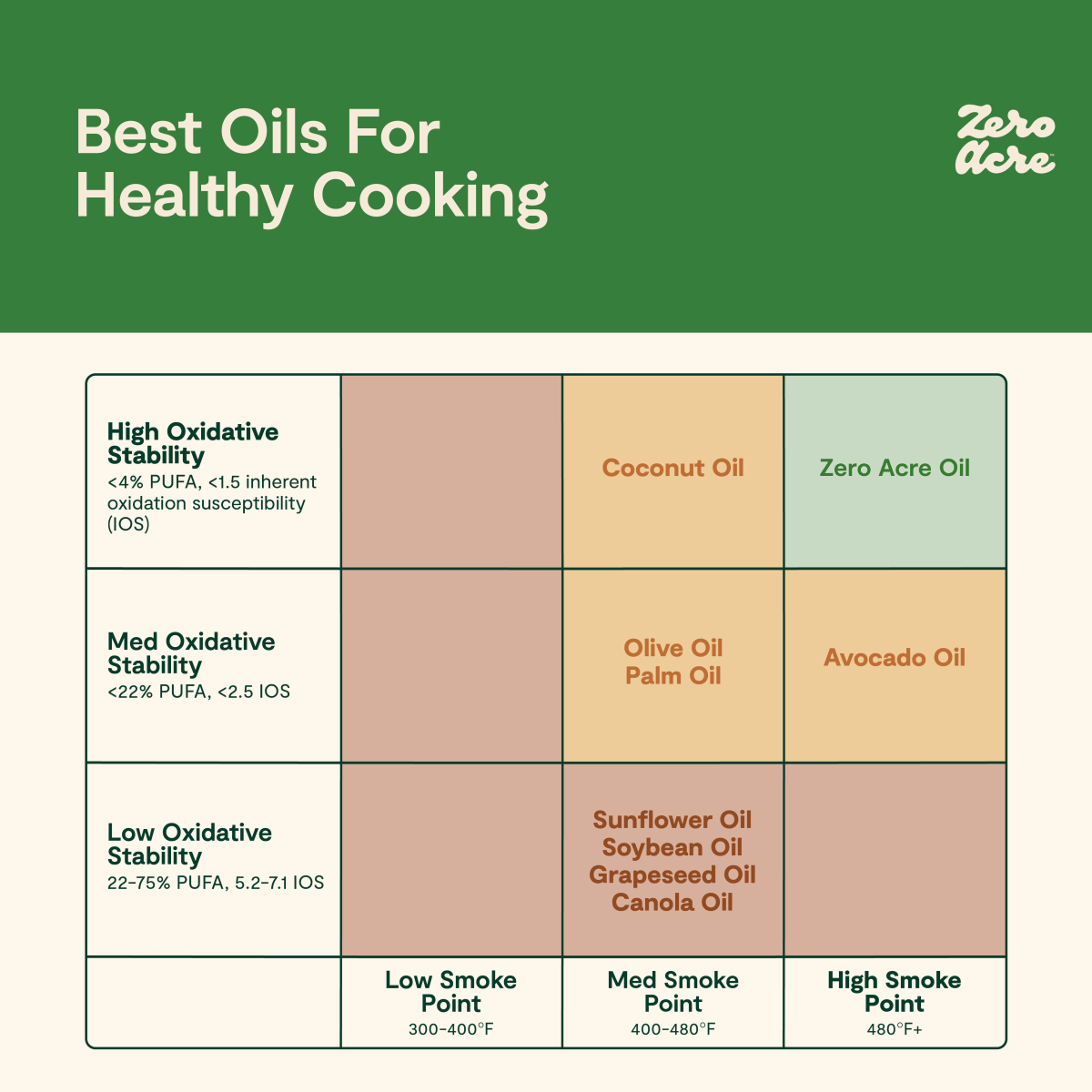
Flavor Neutrality
Frying oils can impart flavors to foods during cooking, which is why most chefs prefer to use oils that are as neutral as possible. You can also choose an oil that complements the desired flavor of your dish.
For example, the tropical flavor of extra virgin coconut oil could be a good choice for sweet coconut shrimp, but probably not for chicken parmesan. And a grassy olive oil might go well with a Mediterranean-inspired dish, but not homemade French fries.
Flavor neutrality or pairing are personal preferences, so you should experiment to decide what you enjoy most.

Tips for Frying Food Correctly
Follow these tips to safely prepare your favorite fried dishes at home — without the downsides of restaurant-fried food.
Fry at Home
Making your own fried food at home isn’t as quick or convenient as buying prepared fried foods, but it’s worth the effort.
Most importantly, frying at home allows you to avoid the unhealthy industrial seed oils that virtually all restaurants use.
You can also choose a specific oil that’s appropriate for the temperature, frying style, and flavor properties you want in your dish. With a bit of practice, you’ll be cooking far better fried dishes than most restaurants.
Frying Techniques
Frying dehydrates the outer surfaces of food and triggers the Maillard effect — a chemical reaction that transforms the structures of carbohydrates and proteins, resulting in the browning and caramelization of the food's surface. This effect is what gives fried food its unique flavor properties.
And because water boils at 212°F and frying involves much higher temperatures, the water in the outer surface of foods immediately begins to boil off and evaporate — leaving the outside crispy and the inside moist.
At home, you’ve got plenty of options for different frying techniques:
Deep-frying involves fully submerging food in fat, making it easy to cook foods quickly and evenly. The downside is that it may require a quart (about a liter) of oil or more, making it more expensive and wasteful.
Pan-frying and shallow frying use enough oil to partially cover the food, which you flip once it’s browned on the bottom side.
Sauteing is similar to pan-frying but only uses enough oil to cover the pan. It’s well-suited to achieving some of the same effects as frying, but generally not used with breading or batter.
Air frying or convection baking uses hot air to cook foods. You can achieve similar results to frying by using fatty foods or coating them with oil before air frying. Wet batters and breading don’t work in air fryers, but you can dredge foods in flour or other ingredients beforehand to add crunchiness.
Be sure to use a frying vessel that’s appropriate for your chosen method. A metal pot or large, deep pan is best for deep-frying, but you can use a shallower pan for pan-frying, shallow frying, or sauteing.
Temperature Control
Temperature control during frying is essential for your food to turn out correctly and avoid creating harmful byproducts.
A clip-on frying thermometer is necessary to manage the temperature of frying oil. There’s a wide range of options, from simple tube or dial thermometers to digital models with temperature alerts.
Before you begin heating oil, it’s wise to prepare the food you plan to fry first. That way, you won’t be rushing or distracted as the oil heats up.
Once you’re ready, you’ll use medium heat to achieve the appropriate temperature:
Deep-frying: 325-375°F (you can also try 375-400°F for some recipes)
Shallow frying: 375°F
Pan-frying: 320-350°F
Sauteing: 320-350°F
Depending on your stove or heating method, this should take about 5-10 minutes, or less time if you’re using a small amount of oil. Don’t use higher heat settings because they may overheat your oil and cause it to smoke.
It may not be possible to use a thermometer for pan-frying and sauteing. The oil should be hot enough that the food immediately sizzles when you add it.
When it’s time to fry your food, use kitchen tongs or a wire basket to add it slowly and avoid splashing hot oil.
Continue to monitor the temperature. The oil may cool to as low as 250-300°F when you add your food, then regain heat. Reduce the heat to low or medium-low if the temperature increases above your target range. As before, don’t use higher than medium heat.
Now you’ll watch the food closely for browning. Unless you’re deep-frying, you’ll flip it when it’s browned on one side. If you’re deep-frying in a pot without a wire basket, it’s also helpful to flip foods to allow them to cook evenly.
The total frying time is usually 3-5 minutes for small pieces and longer for larger items. For meat or seafood, you can use a probe thermometer to check the inner temperature for your desired level of doneness.
Don’t Reuse Frying Oil
Unfortunately, reusing oils even a few times causes harmful changes [*]. It may be attractive economically, but it’s not worth the health consequences of using your oil more than once or twice.
When you dispose of frying oil, don’t pour it down your sink — even small amounts of oil can clog pipes. It’s also not suitable for composting except in very small quantities (such as paper towels used to wipe oil from your counter).
You can pour used oil into a disposable container and throw it away, or find oil recycling programs in your local area.
Ventilate Cooking Oil Fumes
Using a range hood or other kitchen ventilation system is important because cooking oil fumes are harmful to your health.
For example, a Chinese meta-analysis found that increased exposure to cooking oil fumes potentially increases the risk of lung cancer by more than double [*].
Using appropriate heat levels and avoiding vegetable oils high in polyunsaturated fatty acids should help reduce the risks, but ensure your kitchen is as well ventilated as possible [*,*,*].
Frying Safety
Hot oil used during frying can easily cause severe burns, so be careful. Make sure your kitchen is set up so that no one will bump into your frying vessel and spill the oil.
Keep these first aid tips for oil burns in mind:
Cool the affected area with cold running water immediately. You can also place the burned area in a bowl of cold water, but don’t apply ice to the burn.
Turn the heat off or remove the pot or pan from the heat source as soon as possible.
Gently remove rings or other jewelry, clothing, or accessories from the affected area before swelling occurs.
Don’t break or pop blisters.
Apply a soothing lotion or salve, such as cocoa butter or aloe vera.
Cover the burn loosely with a bandage or dressing.
Reapply the salve and change the dressing when needed, but not so often that you’re preventing the skin from healing. Ask your doctor if you’re not sure.
If you get a large or severe burn, cool the area as soon as possible, remove constricting clothing or other accessories from the area, and go to an emergency room or urgent care center for treatment.
Hot oil is highly flammable, especially when heated near its smoke point. If you see smoke, immediately turn off the heat or remove the frying vessel from the heat source when it’s safe to do so. If possible, cover it with a metal lid.
If you have a grease fire in your kitchen, never try to put it out with water. Adding water to burning oil doesn’t help and can cause serious injuries because it produces steam and causes oil to spatter.
Keep a fire extinguisher in an easily accessible area of your kitchen. It’s wise to have a small residential fire extinguisher in your kitchen in addition to a larger extinguisher in another location of your house.
Put your personal safety first. If you can’t safely use a fire extinguisher, or it doesn’t put the fire out, evacuate the building and call 911 or your local emergency line.
The Takeaway
Fried foods from restaurants come with serious health risks, but you can enjoy homemade versions without the downsides. And as your frying skill improves with experience, you’ll find that they’re also tastier.
The single most important consideration is using an oil that’s healthy and appropriate for frying. Use options that are low in inflammatory omega-6 linoleic acid, stable enough to withstand heat, and flavor-neutral (or with a flavor that enhances your recipe).
Also be sure to avoid overheating or reheating oils, use adequate ventilation, and take safety precautions while frying to prevent oil burns and grease fires.

